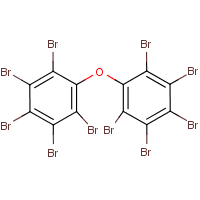Decabromodiphenyl ether
Agent Name
Decabromodiphenyl ether
CAS Number
1163-19-5
Formula
C12-Br10-O
Major Category
Other Classes

Synonyms
1,1'-Oxybis(2,3,4,5,6-pentabromobenzene); AFR 1021; Adine 505; BDE 209; BDE-209; BR 55N; Berkflam B 10E; Bis(pentabromophenyl) ether; Bis(pentabromophenyl)ether; Bromkal 82-0DE; Bromkal 83-10DE; Caliban F/R-P 39P; DB 10; DB 101; DB 102; DE 83; DP 10F; De 83R; Decabrom; Decabromobiphenyl ether; Decabromobiphenyl oxide; Decabromodiphenyl ether; Decabromodiphenyl oxide; Decabromophenyl ether; EB 10; EB 10FP; EB 10W; EB 10WS; EBR 700; Ether, decabromodiphenyl; F/R-P 53; FR 10; FR 10 (ether); FR 300; FR 300BA; FR-PE; FR-PE(H); FRP 53; Fire Cut 83D; Flame Cut 110R; Flame Cut Br 100; Nonnen DP 10; Nonnen DP 10(F); PBED 209; Pentabromophenyl ether; Planelon DB; Planelon DB 100; Planelon DB 101; Plasafety EB 10; Plasafety EBR 700; Saytex 102; Saytex 102E; Tardex 100; Benzene, 1,1'-oxybis(2,3,4,5,6-pentabromo-; [ChemIDplus] DBDPO; DBDPE; [AIHA]
Category
Halogenated Polyaromatics
Description
White solid; [HSDB] Faintly beige powder; [MSDSonline]
Sources/Uses
Used in high impact polystyrene and other polymers; Used as a flame retardant in thermoplastic resins, thermoset resins, textiles, and adhesives; [HSDB] Used as flame retardants since the 1970s in carpet lining, mattresses, chairs and sofas (polyurethane foam), and casings for televisions and computers; 209 congeners of polybrominated diphenyl ethers (PBDEs) exist, but only 13 are usually found in commercial mixtures; Electronic recycling workers have increased blood levels; [Reference #1]
Comments
A skin, eye, mucous membrane, and respiratory tract irritant; May cause kidney and liver injury; [CAMEO] Low acute oral toxicity in animal experiments; [HSDB] An irritant; Targets spleen, thyroid, liver, and kidneys; [MSDSonline] Practically nontoxic on acute toxicity testing; Not considered a reproductive hazard; Lesions of the liver, kidney, and thyroid gland in high-dose, subchronic feeding studies of rats; [AIHA] In high-dose animal experiments, polybrominated diphenyls (PBDEs) cause increased cancer, reproductive toxicity, and behavioral changes. Several human studies found associations between PBDE serum levels and reproductive adverse effects. [Reference #1]
Reference Link #1
Biomedical References
Exposure Assessment
Bioaccumulates
Yes
Vapor Pressure
4.67E-12 mm Hg
WEEL
5 mg/m3
Adverse Effects
Hepatotoxin
Hepatoxic (a) from occupational exposure (secondary effect) or (b) in animal studies or in humans after ingestion
IARC Carcinogen
Not classifiable
Diseases, Processes, and Activities Linked to This Agent
Processes
Industrial Processes with risk of exposure: